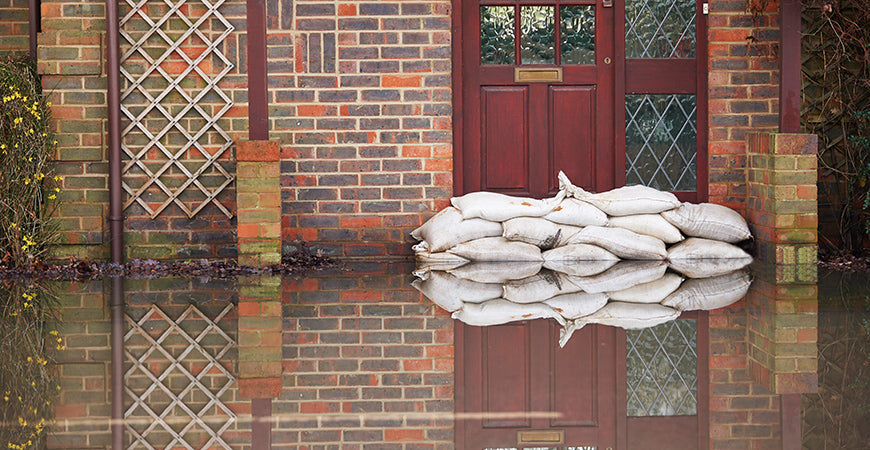on all US orders over $99
on all US orders over $99

Here at UNI KEY, our hearts and prayers are with the flood victims in South Texas. Our founder, James Templeton grew up in Houston, and many of us have family and friends there. We are deeply saddened by your loss and stand beside you – Texas Strong.
During the initial shock of a natural disaster like a hurricane or severe storm that causes flooding, we don’t consider the health implications of what those high water levels really mean. We assume we have the technology and resources to keep things clean. But the reality is even the water seeping into million dollar homes is contaminated with everything from pesticides to sewage, and there are health risks associated with flooded conditions we need to protect ourselves from.
Floodwater is often contaminated with sewage and animal wastes, and contact with this water commonly causes gastrointestinal illness from the bacteria, viruses and parasites present in the water. Floodwaters have been found to contain parasites like Giardia and amoebae; bacteria including E.coli, Salmonella, and Shigella; viruses including Hepatitis A, Rotavirus, Parvovirus and the viruses that cause what we commonly call the stomach flu. Even after the waters recede, these pathogens can still be present in areas that flooded, including your home.
Strengthening your digestive system is key to avoiding these GI flood illnesses. The stress of a tragedy like this causes inflammation in the lining of your intestines, so supplementing is a good idea for everyone. Start with the basics, a good quality probiotic in higher than normal doses to populate your intestines with the health-protective good bacteria. Take an anti-parasitic supplement like Para-Key to help your immune system fight off anything you do come in contact with. And as always, frequent hand washing with clean water goes a long way to preventing disease of all kinds.
Many microbes grow in damp spaces besides mold and are easily transmitted airborne or through insects like mosquitoes, whose population explodes after a flood. Aerosolized bacteria like Legionella from floodwaters grows well in damp HVAC units and ductwork, causing serious respiratory infection and illness. Other sources of respiratory illness are often allergic or irritant in nature, especially in asthma-prone people. Indoor use of gas-powered generators, pressure washers, water pumps, and more can cause carbon monoxide poisoning without adequate ventilation or against manufacturer warnings for outdoor use only.
Strengthen your immune system with a good quality probiotic, and protect your respiratory system with Vitamin C and a liposomal glutathione supplement. Consider a broad spectrum anti-infective like colloidal silver when infection potential is high. A good natural insect repellent is a must when mosquitoes swarm. An N-99 respirator mask filters out airborne chemicals and particles including mold that you can come in contact with while cleaning up after a flood. Affected ductwork often needs to be replaced by a professional. Our trusted source for air purifiers is CWR and they will make recommendations based on your individual needs.
Mold counts are extremely high both indoors and outdoors following a flood. Exposure should not be taken lightly. Mold illness ranges in severity from the irritation of a rash or nagging cough to more serious symptoms including pneumonia, extreme weakness and tachycardia. Do not cut corners remediating a flood damaged home; mold can grow in such hard to reach places as insulation in the wall behind cupboards. It doesn’t have to be seen to be deadly, the most toxic mold – stachybotrys has been known to grow inside walls and cause illness without ever becoming visible.
Pine oil-based products are the most effective natural choice when cleaning up after mold remediation. Though there is conflicting advice regarding the use of bleach solutions, research shows it causes mold to sporify as it dies which creates more airborne mold-related illness. Rather than bleach, consider a borax detergent solution or pine oil cleaner.
For your personal health, consider supplementing with oregano oil capsules, Vitamin C, a binder like zeolite, and Y-C Cleanse to help your immune system fight off the mold you inevitably will come in contact with. Eat foods rich in quercetin like apples and pears to reduce irritation and inflammation. Foods like garlic, leeks and onions are rich in allicin and a good addition to the diet, as a potent antioxidant and antimicrobial. If you know you are sensitive to mold, follow an anti-candida/mold diet and avoid sugars, fruits and fermented foods until the mold issues have been resolved and counts are lower.
It’s never more important than after a flood to protect the quality of your drinking water. Heavy metals, sewage residue, pesticides and other chemicals, organic compounds like petroleum, and the pathogens already mentioned can be present in the water supply, and municipal filtration systems are not always equipped to handle these contaminants. This is where a good quality water filter comes in, one that requires no electricity and gives you safe drinking water. Even bottled water can be contaminated and is in short supply during a severe weather situation. Whether you decide to install a whole house filtration system or a portable tabletop filter attached to the kitchen faucet, clean water is essential to staying healthy in the aftermath of a flood.
CWR for air purifiers: cwrenviro.com
UNI KEY offers a variety of water filters here.
References
“Fact Sheet: Flood Cleanup – Avoiding Indoor Air Quality Problems,” EPA Office of Radiation and Indoor Air, http://www.epa.gov/iaq/pubs/flood.html
Creating a Healthy Home: A Field Guide for Cleanup of Flooded Homes, National Center for Healthy Housing and Enterprise Community Partners, http://www.centerforhealthyhousing.org/FloodCleanupGuide_screen_.pdf
“Dealing with Mold & Mildew in your Flood Damaged Home,” FEMA, http://www.fema.gov/pdf/rebuild/recover/fema_mold_brochure_english.pdf
https://www.epa.gov/sites/production/files/2014-08/documents/flood-related_cleaning_report.pdf
Leave a comment